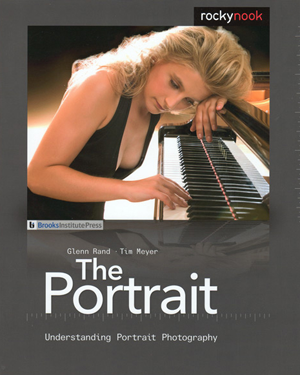
The Portrait-Understanding Portrait Photography
By Glenn Rand and Tim Meyer
Rocky Nook Publishers
http://www.rockynook.com
US $34.95, CAN $41.95
ISBN: 978-1-933952-46-8
187 pages
This stellar collaboration between Glenn Rand, educator and Program Director for Graduate Programs at Brooks Institute, and Tim Meyer, Portrait Division Chair at Brooks Institute, is a blessing for all photographers interested in portraiture. More specifically, it shows us what makes a portrait great. The Portrait – Understanding Portrait Photography is a “definitive resource for professionals, as well as students and avid amateurs.”
Glenn Rand and Tim Meyer have kept this diminutive tome on task. Instead of a book listing all the technical devices available to photographers, what these devices do, how to use them, and all the accompanying technobabble that goes with it, they have stayed the course of practicality. Granted, there are many types of lights, flashes, and meters available to help photographers create their desired image. But without a grounded knowledge showing us what works and what doesn’t the devices are almost useless. There are enough references and explanations in this book about light meters, umbrellas, soft boxes, and the like to keep even the most avid technoid happy. But the soul of this book is in the practical and real-world application of what kinds of light do what, and why, and how. The many photo examples in this book will brilliantly illustrate each lesson as the authors take us through the subject matter.
From the dawning of man’s endeavor to reproduce himself in art, portraiture has been a large part of his attempt to define himself and others. Some of the world’s greatest artists including Leonardo da Vinci, and Rembrandt von Rijn, are used by Glenn Rand and Tim Meyer as examples of classic portrait artists and the techniques they used.
Our authors put photographic portraiture contextually within the rest of art-world portraits by giving us a comprehensive glimpse of how portraits came to be. In the early days of photography experimentation was nurtured with the knowledge of how the great master painters and even sculptors produced portraits. Instead of brushes, paints, and canvas, photographers had silver amalgams, salt and silver paper, shutters, and irises to do their bidding. Though the media used in painting and sculpture is quite different from that of photography the rules and successes of the past held true then, as they do today.
When photography began to offer affordable access to the masses in the second half of the 19th century some artists claimed that photography would be the death of painting. After all, instead of the model sitting for days or even weeks in order to give the artist time to create the likeness, with photography an accurate likeness of the model would take only a few minutes by comparison.
We all know now that the “death of painting” prediction was totally untrue. Painting and photography may be two totally different mediums, but now, with the tools of photography, a person didn’t have to have a ton of artistic talent to create an image. They only needed some basic equipment, and some fundamental knowledge of the chemical activity that causes the prints to appear to make a picture more perfect than most artists could paint. It is easy to see why some artists were reluctant to accept photography as an art form.
But creating an image with a camera demanded its own form of creativity and artfulness. Photographers soon began using the same techniques that painters used in order to get the subject to look as they envisioned. The study of lighting techniques became essential, along with the creation of newer and better equipment, better chemicals, and through hard work, better photographers. Now, in our modern and highly technological present, digital photography demands new understanding and language. But the basics about lighting, form, and function remain true for the photographer as much as these techniques were true for the painter and sculptor centuries ago.
All of the parameters of portraiture are covered in The Portrait – Understanding Portrait Photography, including: face shape, light dynamics, light modification, exposure and metering, lighting ratios, lighting patterns, setups, backgrounds, and much more. The student of portraiture will learn all of the classic ways of lighting a face or whole person(s), creating portraits which express the subject, as well as the photographer’s vision, and rules, which, by the authors’ own admission, must be learned first in order to be broken. And yes, the authors advise that all of the rules written in this book are not there to keep photographers from deviating from them. On the contrary, it is the deviating from formal rules that creates new and exciting art. One has only to look at El Guernica http://www.artchive.com/artchive/p/picasso/guernica.jpg by Pablo Picasso to understand this function.
After perusing the images and reading the lessons in The Portrait – Understanding Portrait Photography I cannot imagine a more readable and knowledgeable and fun way to learn about creating portraits through photography. Many of us photographers have already been doing some of the lessons the authors teach, quite by accident, but without the knowledge that goes along with it. Armed with this knowledge it is easy to see that just a few tweaks here and there from our normal session can greatly increase our ability to communicate, through photography, our vision of our subject. This book is a must-have for any photographer interested in creating compelling and artful portraits.
email – MyMac Magazine – Twitter – Advertise – Reviews Archive – Podcast

Great review, one of the best post I checked out so far. I’m want to know, have you ever before read any photography home based business book by Allworth Press? Possibly you could compose a evaluation for it, it appears like a great publication to read.